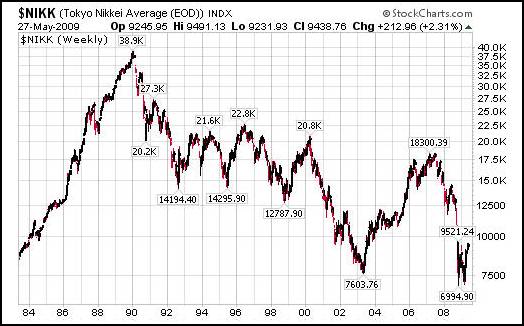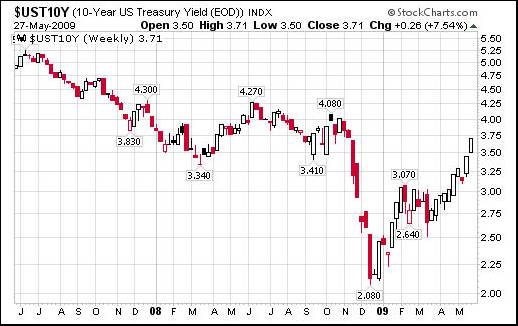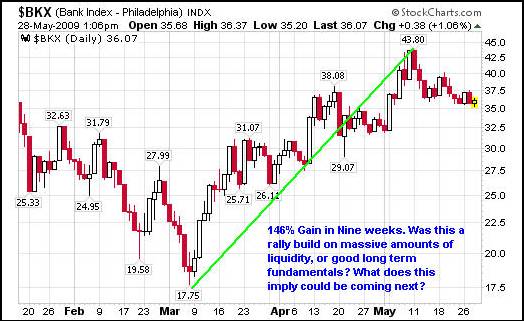The Next Debt Landslide: Lessons from Andrew Carnegie
Interest-Rates / Credit Crisis 2009 May 29, 2009 - 03:33 PM GMTBy: Doug_Wakefield
 Here we are, sitting in our homes or businesses reading commentary about the craziness of the world in which we live. While our collective response to rising markets has always been, “this is good,” never before have we been asked to trust so implicitly in ideas that are so far removed from the lessons of world history. While our political and financial leaders keep telling us that the capacity for debt production is eternal, Andrew Carnegie disagrees. If your friends don’t recognize that name, remind them that Carnegie had a little money in the 1800s. Carnegie Hall, Carnegie Mellon University, the Carnegie Endowment for International Peace, and the Carnegie Foundation for the Advancement of Education all bear his name.
Here we are, sitting in our homes or businesses reading commentary about the craziness of the world in which we live. While our collective response to rising markets has always been, “this is good,” never before have we been asked to trust so implicitly in ideas that are so far removed from the lessons of world history. While our political and financial leaders keep telling us that the capacity for debt production is eternal, Andrew Carnegie disagrees. If your friends don’t recognize that name, remind them that Carnegie had a little money in the 1800s. Carnegie Hall, Carnegie Mellon University, the Carnegie Endowment for International Peace, and the Carnegie Foundation for the Advancement of Education all bear his name.
Carnegies’ book, Triumphant Democracy, was published in 1886. It can be purchased for a few bucks from a variety of bookstores. As you read this excerpt, remember that, just like today, Carnegie wrote in a historically significant time:
National debts grow troublesome. Year after year the burden they lay upon the productive energies of nations becomes harder and harder to bear. The twelve years between 1870 and 1882 have eclipsed all others in the amounts added to the already sorely burdened masses of Europe. Russia has saddled herself with $1,365,000,000 (₤273,000,000) more debt in these short twelve years, an average increase of nearly $115,000,000 (₤23,000,000) per annum, a load fit to weigh an empire down.
France’s obligations have swollen to $2,215,000,000 (₤ 443,000,000) and even Spain must be in the fashion and add $525,000,000 (₤105,000,000), and Italy, not to be behind in this mad race, has contracted $740,000,000 (₤148,000,000) more, and even poor decaying Turkey has found credulous capitalists to lend her $90,000,000 (₤18,000,000) during this period. The aggregate of these obligations in Europe has increased, since 1848, from $14,940,000,000 (₤2,988,000,000) to $20,935,000,000 (₤4,187,000,000), and most of this increase has been consumed in wars which have left matters much as they were or would have been, if never waged. (Page 356)
Some of you are thinking, “Damn, if debt was that bad then, why is the global solution being offered today to blow fiscal spending and expand debt like crazy?” Hold onto that question for a moment, and let’s return to 1800s to see if Carnegie found any respectable actors in the debt deluge:
Such, is the inevitable result of antidemocratic rule. Britain alone, let us record it to her credit, is the only power which has resolutely reduced her debt. It is less by $465,000,000 (₤ 93,000,000) in 1884 than it was in 1857, while her wealth has enormously increased. It is easy to meet deficits by the proceeds of new loans…Nations forget this peculiarity of new issues; sleeping or waking the load of interest swells noiselessly on Saturdays and Sundays alike.
The Republic [America] emulated her mother’s [Britain] example and cuts down her debt with unexampled rapidity. It is a curious fact that these, the two English-speaking nations, should be the only ones who resolutely set their faces strongly in the debt-discharging direction. The other races appear content to borrow as long as they can and let the future take care of itself. We are not without ominous signs that in some instances the strain upon their resources cannot be increased further without danger. Perhaps the Democracy is soon to awaken to the truth that these vast accumulations of debt have their real source in the rule of monarchs and courts, whose jealousies and dynastic ambitions, stimulated by the great military classes always created by them, produce the wars or continual preparation for wars which eat up the people’s substance and add to their burdens year after year. A nation with a large standing army and navy is bound to make wars.
Our great advantage which the Democracy has secured for itself in America is its comparative freedom from debt. The ratio of indebtedness to wealth is strikingly small. (Page 357)
Now stop, take a deep breath, and think. If Andrew Carnegie gave these words as a speech today, would any of the collective group of government leaders welcome his thoughts? How many financial leaders would offer him a job? Having stated that, “Our great advantage which the Democracy has secured for itself in America is its comparative freedom from debt,” one wonders if he would even be given an office in the very foundations that bear his name?
Last week, I read an article in which the author stated that today the U.S. is experiencing a “balance sheet” recession, making me think of Dr. Richard Koo’s (2003) book, Balance Sheet Recession: Japan’s Struggle with Uncharted Economics and its Global Implications. Before returning to Japan, where he eventually became the Chief Economist of Nomura Securities, Koo started his career with the New York Fed. As you consider his comments, remember that Koo has already lived through a historical situation which we have never seen; a stock market that today, twenty years later, stands at a lower level than it did in 1989.

Like Carnegie, Koo’s comments supercede today’s theories, for they are gleaned from the historical record.
The Bank of Japan has reduced interest rates as low as possible in order to induce people to borrow and spend. As a result, the present interest rates in Japan are the lowest ever recorded in human history. The benchmark 10-year Japanese government bond is now (mid-January 2003) yielding 0.8%. Although interest rates are as low as they could possibly be, 70-80% of companies in the country are still rushing to pay down their debts. (Pages 40-41)
Having lived our lives during the greatest explosion of debt in world history, Carnegie’s “freedom from debt” is a foreign language. It is beyond our ability to comprehend. We have been brainwashed to believe that if only rates are low enough, eventually individuals and business owners will borrow money like crazy again. Koo makes it very clear why this exact policy has already failed in Japan:
There is a good reason why monetary policy is not effective. For monetary policy to be effective, there must be many people in the private sector who respond to the central bank’s cuts in interest rates. In other words, there should be many people who are induced to save less, to buy a home, or to invest in plant and equipment in response to the lowering of interest rates by the central bank. It is only when the reduced savings or newly borrowed money is spent that income is generated for the next person and the economy moves forward. In other words, it is not lower interest rates per se that improve the economy rather, it is people’s reaction to lower interest rates (that is, borrowing money to spend or saving less) that improves the economy.
When the balance sheets of corporations are impaired, however, they are likely to make paying down debts their top priority. For those companies, borrowing money is the last thing on their mind. When the vast majority of the companies in an economy are in this category, however, the whole economy ceases to respond to the lowering of interest rates by the central bank. (Page 40)
So with the hundreds of millions the world’s leaders continue to spend in economic and financial stimulus to try to make the debt-addicted take on more debt, the answer is simple. It is wrong. Carnegie knew it more than 120 years ago, and Koo made it plain from Japan’s recent monetary history. Koo makes it quite clear that when the crowd, individually, locally, or nationally, decides that taking on too much debt was never in their best interest in the first place, handing out toasters and other enticements to take out new loans will not work.
Continuing my search for those with historical experience, I recently caught up with Jerry Flum, CEO and founder of Credit Risk Monitor, a company that monitors and evaluates credit risk on more than 35,000 companies around the globe. A 41-year veteran of financial markets, Flum started in the financial industry in 1968 as a security analyst for Oppenheimer and began running his own hedge fund in 1973, at the beginning of the 1973-1974 bear market, over which time the Dow plunged 45 percent. The following comments are taken from a recent interview, where I asked him whether he thought the March 9th bottom was THE bottom:
“FLUM: Now, you and I discussed debt a long time ago, and debt basically allows a person, or a corporation, to buy something in the present tense that they don’t have enough current income to buy. Suppose I want to buy a car, but I don’t have the money to buy a car now. If the car dealer loans me 90 or 100 percent of the value of the car, I can still buy the car now. As a result, a future demand unit has gone into the present tense – I don’t need to buy a car 2 years from now; I already have one. So debt allows a person to move their purchase decisions forward, which accelerates growth and GDP. But, at the end of the day, the game is limited. When you have 3 cars in a 2-person family, that tends to limit future car sales.
So, when I look at what the President’s plan is now, and what the Congress and everybody’s trying to do, I am astounded by it. At the end of the day, here’s what they are trying to do: we’ve got the American consumer, with no savings and who has, for the most part, been wiped out in real estate – because if he has a $160,000 mortgage on a house he purchased for $200,000, but is now worth $160,000, he has very little, if any, equity left in the house. And to top it all off, his 401k and his pension and everything else is down 30 to 40 percent.
So, this consumer has no savings; his assets have shrunk, and the President of the United States, and everybody, has an economic policy which, for the most part, is trying to force banks to lend money to that consumer, so he can go out and buy another TV set or another car.
It’s ethically and morally bankrupt, and it’s an atrocious policy for our government to try to get that person to borrow more money to consume when that person should be saving. It’s insane. The fundamental policy of the government is to come in and get the banks to lend to a consumer, who represents 70 percent of the GDP, who’s nearly busted… you know, sometimes I wonder if I’m on the same planet with everybody.”
So, after the geniuses at the Fed decided to cut the discount rate to between zero and .25%, or more recently decided to start purchasing $300 billion in long-term US Treasuries, with more debt created out of thin air, what are higher Treasury yields trying to tell stock investors about the real world of debt and its impact on real people and economies in the future?

Does it look like the “stress test” the US Government has been going through since mid December, and more recently since March 18, had any negative impact on the nations largest lenders?

In writing about this maddening time in history for five years now, I note three trends that have continued unabated. First, government leaders, as a whole, have become more subservient to those in control of money, resulting in ever-faster exploding debt. Secondly, due to a rapid expansion of government inefficiencies and the political corruption that goes hand-in-glove with misusing perceived “unlimited power” to appease and please, rather than to lead, the economic and financial systems show more signs of instability today than they did two years ago. And finally, the crowd, by and large fearing the hardship that will accompany any real remedy, desires to remain uninformed so long as their personal lives are not affected. While things looked bad in the fall of 2008, as equity prices fell around the world, the rise of the same, since that time, has comforted the crowd and lulled many back to sleep. Human nature being what it is, this was a much easier alternative to trying to understand the confusing and frightening, historically unprecedented and obfuscated shifts that have rapidly taken place.
So, where are we going next? If we want to understand, we should not look for the stock market’s price in the next few days or the price of gold in the next week, but the operations of the world of money in the future. If this goes anything like 1929-1932, a period in which the Fed increased its purchases of government securities rapidly while individual and business borrowing plummeted, then we are likely to see this thing we call “money” change drastically. The up and down volatility we have seen in the last 2 years is not going away anytime soon. When the strains on the current currency regime reach a plainly unsustainable point, we will see more policies like the one the G-20 presented on April 2:
The summit of many of the world's leading economies in London announced a tripling of the lending power of the International Monetary Fund to around $750 billion.
They also unveiled a $250 billion expansion in the IMF's reserve currency -- the special drawing right -- to boost liquidity in the global financial system by expanding member countries' foreign exchange reserves.
The Special Drawing Rights page of the International Monetary Fund’s website, informs us that we have had a small amount of an international currency, not a national or regional currency, since 1969. On April 2, 2009 the number of units of that currency expanded 8-fold from a value of about 21.4 billion units to 250 billion in US dollars. A quick visit to the IMF website, where the SDR is valued weekly, shows that currently, as of May 28 2009, 250 billion in US dollars is equivalent to about $163 billion in SDRs. When we consider that fact that this newly printed international currency, outside the sovereignty of any nation or its voters, was granted the authority to issue a fresh batch of international loans to the tune of $1 trillion dollars, we begin to grasp the enormous power shift that was begun two months ago.
Now I can only speculate, but wouldn’t it make sense that if things got really bad out there in the future that, at some point, our illustrious leaders would tell us that, for our own good, they have decide that a new global regulatory structure is needed, which will be established alongside this new global currency? I know it sounds crazy. Maybe I’ve just watched just one too many science fiction movies. Then again, many of our government’s actions almost appear to be scripted.
If you are looking for a collection of ideas, built around lessons of history, science, and individual and crowd psychology, check out The Investor’s Mind.
By Doug Wakefield with Ben Hill,
President
Best Minds Inc. , A Registered Investment Advisor
3010 LBJ Freeway
Suite 950
Dallas , Texas 75234
doug@bestmindsinc.com
phone - (972) 488 -3080
alt - (800) 488 -2084
fax - (972) 488 -3079
Copyright © 2005-2008 Best Minds Inc.
Best Minds, Inc is a registered investment advisor that looks to the best minds in the world of finance and economics to seek a direction for our clients. To be a true advocate to our clients, we have found it necessary to go well beyond the norms in financial planning today. We are avid readers. In our study of the markets, we research general history, financial and economic history, fundamental and technical analysis, and mass and individual psychology.
Disclaimer: Nothing in this communiqué should be construed as advice to buy, sell, hold, or sell short. The safest action is to constantly increase one's knowledge of the money game. To accept the conventional wisdom about the world of money, without a thorough examination of how that "wisdom" has stood over time, is to take unnecessary risk. Best Minds, Inc. seeks advice from a wide variety of individuals, and at any time may or may not agree with those individual's advice. Challenging one's thinking is the only way to come to firm conclusions.
Doug Wakefield Archive |
© 2005-2022 http://www.MarketOracle.co.uk - The Market Oracle is a FREE Daily Financial Markets Analysis & Forecasting online publication.



